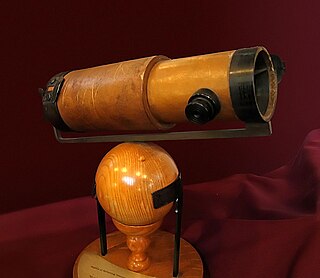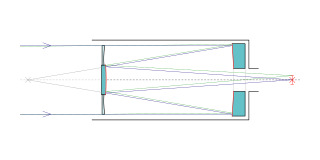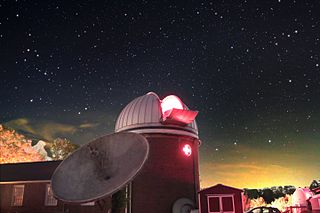
The Newtonian telescope, also called the Newtonian reflector or just the Newtonian, is a type of reflecting telescope invented by the English scientist Sir Isaac Newton (1642–1727), using a concave primary mirror and a flat diagonal secondary mirror. Newton's first reflecting telescope was completed in 1668 and is the earliest known functional reflecting telescope. The Newtonian telescope's simple design has made it very popular with amateur telescope makers.

The Maksutov is a catadioptric telescope design that combines a spherical mirror with a weakly negative meniscus lens in a design that takes advantage of all the surfaces being nearly "spherically symmetrical". The negative lens is usually full diameter and placed at the entrance pupil of the telescope. The design corrects the problems of off-axis aberrations such as coma found in reflecting telescopes while also correcting chromatic aberration. It was patented in 1941 by Russian optician Dmitri Dmitrievich Maksutov. Maksutov based his design on the idea behind the Schmidt camera of using the spherical errors of a negative lens to correct the opposite errors in a spherical primary mirror. The design is most commonly seen in a Cassegrain variation, with an integrated secondary, that can use all-spherical elements, thereby simplifying fabrication. Maksutov telescopes have been sold on the amateur market since the 1950s.

The Schmidt–Cassegrain is a catadioptric telescope that combines a Cassegrain reflector's optical path with a Schmidt corrector plate to make a compact astronomical instrument that uses simple spherical surfaces.
The Fick Observatory was an astronomical observatory owned and operated by Iowa State University. Located southwest of Boone, Iowa it was named after Davenport, Iowa amateur astronomer Erwin W. Fick. The observatory closed in 2015.
Bowman Observatory is an astronomical observatory owned and operated by the Greenwich, Connecticut Board of Education.
Stull Observatory is an astronomical observatory owned and operated by Alfred University. Named after Dr. John Stull, who helped establish the observatory in 1966, it is located in Alfred, New York (USA). It is notable for housing seven independently housed telescopes ranging in size from 8 to 32 inches. The largest, the Austin-Fellows 32 inch Newtonian Reflector is tied with the Vassar College Class of 1951 Observatory for the rank of second largest optical telescope in New York state after the 40 inch telescope at SUNY Oneonta College Observatory. Telescopes at the observatory are regularly opened to the public. The observatory is also used for those pursuing a minor in astronomy or a concentration in astrophysics.
C. E. K. Mees Observatory is an astronomical observatory in Bristol, New York, owned and operated by the University of Rochester. The observatory is named after C. E. Kenneth Mees, "in honor of his pioneering work in the development of sensitive photographic emulsions for use in astronomy."

Custer Observatory is an astronomical observatory owned and operated by Custer Institute. Located in Southold, New York (US), facing Peconic Bay and Shelter Island, Custer's location boasts some of the darkest skies on Long Island.

The Allan I. Carswell Astronomical Observatory, formerly known as the York University Astronomical Observatory, is an astronomical observatory owned and operated by York University. It is located in the North York district of Toronto, Ontario, Canada. Opened in 1969, York's observatory is opened to both researchers and amateur astronomers. The observatory was renamed the Allan Ian Carswell Astronomical Observatory in 2017 after York University Emeritus Professor of Physics Allan Carswell.

Green Point Observatory is a private observatory in Oyster Bay, Sydney, Australia, and is the home of the Sutherland Astronomical Society. It is located at the corner of Green Point and Caravan Head Roads. It consists of a dome, library, 41 centimetres (16 in) Newtonian telescope, a meeting hall seating 100 people, and a roll-off roof observatory with a 35 centimetres (14 in) Schmidt Cassegrain Telescope. The observatory is used by members of the society for observing stars and eclipses, research, astro imaging as well as hosting public education courses and monthly open nights.

The Hirsch Observatory is an astronomical observatory at Rensselaer Polytechnic Institute (RPI) in Troy, New York. It is located on the roof of the Jonsson-Rowland Science Center and is used by members of the Rensselaer Astrophysical Society as well as astronomy students in laboratory exercises. It is frequently opened to the community for public viewing sessions. The observatory's main dome contains a 16" Cassegrain Reflector, with a CCD camera and fully computerized controls. The observatory also owns a variety of smaller scopes and a SBIG Spectrograph. The spectrograph has been used to catalog bright solar spectrum as part of an effort to create an online digital database for astrophysical research. The current director of the observatory is Professor Heidi Newberg.

The Givatayim Observatory is a public observatory that was founded in 1968 by the Israeli Astronomical Association and the Givatayim municipality.

The Heights Observatory is an Astronomical Observatory at The Heights School in Modbury Heights, Adelaide, South Australia.

J A Jones Hoober Observatory is a privately owned observatory located in South Yorkshire, England near to the villages of Hoober and Wentworth, 4 miles (6.4 km) North-northwest of Rotherham. It can be found about 300 metres (0.19 mi) east of Hoober Stand. The observatory is owned and operated by Mexborough & Swinton Astronomical Society (NPO).
The SUNY Oneonta College Observatory is an astronomical observatory in Oneonta, New York. The observatory is home to the largest optical telescope in New York: a 1-meter Newtonian reflector. It is also believed to be the one of the largest telescopes open for public observing east of the Mississippi. The telescope was constructed by JMI Telescopes of Lakewood, Colorado.
The Von Braun Astronomical Society is a society of amateur and professional astronomers dedicated to education and public outreach on behalf of astronomy based in Huntsville, Alabama, United States.
Mount Burnett Observatory is an astronomical observatory in Mount Burnett, Victoria, Australia.
The Dark Sky Observatory (DSO) is an astronomical observatory owned and operated by Appalachian State University (ASU). It is located 9 kilometers (5.6 mi) east of Deep Gap, North Carolina (USA), off of the Blue Ridge Parkway, and 32 kilometers (20 mi) east of the ASU campus in Boone, North Carolina It was established in 1981, and is used for research, instruction, and public viewing events. The Cline Visitors' Center was completed in 2011.
Tortugas Mountain Observatory (TMO) is an astronomical observatory owned and operated by New Mexico State University (NMSU). It is located on Tortugas Mountain, also known locally as 'A' Mountain, in southern New Mexico (USA), approximately 8 kilometers (5.0 mi) southeast of Las Cruces and 4 kilometers (2.5 mi) east of the NMSU campus. Founded in 1963 under the supervision of Clyde Tombaugh, the observatory focused on observing the planets. Much of the information captured at TMO is now available through the Planetary Data System's Atmospheres Node, which is managed by NMSU. The two-dome observatory building was completed in 1964, though observing began with one of the telescopes in 1963. A second building, with a larger single dome, was completed at the opposite end of the ridgeline of Tortugas Mountain in 1967. Regular use of TMO ceased in 1999 or 2000, but the observatory equipment was not dismantled. In 2008 it was used for the Lunar CRater Observing and Sensing Satellite project. In 2010, efforts to revive the observatory for use by the American Association of Variable Star Observers began. As of 10 June 2011, work on project was reported to be 60-75% done.
Sheep Hill Observatory is an Astronomical observatory located in Morris County, New Jersey. It features an 18-inch (457mm) Newtonian reflecting telescope and is open to the public on the 3rd Friday evening of each month, weather permitting. It is also made available to Schools, Scouting Groups and other educational groups upon request.










